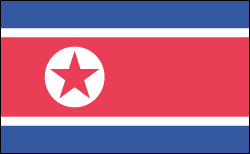2013 World News: North Korea

Nuclear Weapons Testing Rachets Up Tension with U.S., South Korea
In 2013, North Korea continued to inch toward developing the expertise to build an intercontinental ballistic missile. North Korea said in February it had detonated a nuclear bomb—the third in a year. The explosion was larger than North Korea's previous tests. In response to the test, the UN Security Council unanimously passed another round of strict sanctions against North Korea. In a first, China was involved in drafting the sanctions. The sanctions came shortly after the U.S. and South Korea began annual military drills near the north-south border. Reacting to the sanctions and the exercises, President Kim Jong-un promised to launch "a pre-emptive nuclear strike" against the U.S. and South Korea. He also said he had voided the 1953 armistice that ended the war between North and South Korea, essentially declaring war with the South. Kim's threats were mostly dismissed as bluster but were nevertheless the most menacing in years. He continued his bellicose tone in March and shut down not only Red Cross hotlines between North and South Korea but also military hotlines. At a rare plenary meeting of the Central Committee in March, Kim said North Korea would continue to develop its nuclear weapons program despite sanctions and restart the mothballed nuclear facility in Yongbyon. In early April Kim prohibited South Korean workers from entering the Kaesong industrial park, which is run jointly by the two countries and located in North Korea. In response to the growing threat from North Korea—and to support the South—the U.S. sent F-22 stealth fighter jets and B-2 and B-52 bombers to the region. The U.S. also increased the number of ground-based ballistic missile interceptors in California and Alaska and deployed an advanced missile defense system, Terminal High Altitude Area Defense (Thaad), to Guam two years earlier than planned. Calmer Heads Prevail After Talks Between the North and SouthThe Kaesong complex re-opened in September after several rounds of talks between North and South Korea. In addition, North Korea said it would resume a program that allows family members separated by the war to visit each other. Newly elected South Korean president Park Geun-hye said the breakthroughs were evidence that her policy of "trustpolitik" had made progress. However, the encouraging news was tempered by reports of steam rising from the weapons-making nuclear reactor at Yongbyon, suggesting that North Korea may have reopened the facility. Reported Leadership Shuffle Sparks ConcernIn December 2013, Kim Jong-un sacked his uncle, Jang Song-thaek, and other government and military leaders held over from his father's rule. When Kim took power, Jang was assigned to supervise and advise Kim and was considered the second most powerful figure in the country. The Korean Central News Agency said Jang was ousted for heavy drinking, womanizing, challenging the leadership of Kim, and selling resources below market value. Days later, on Dec. 13, North Korea announced that Jang had been executed for attempting a coup. Jang "persistently plotted to spread his evil design into the military, believing that he could overthrow the leadership if he could mobilize the military," the news agency reported. It was an extraordinary show of transparency from the world's most secretive societies. The upheaval could signal Kim's attempt to put his own handprint on the government—or a power struggle. Observers feared the repercussions if a power struggle led to further instability. —Beth Rowen |
- More from 2013 Year in Review









